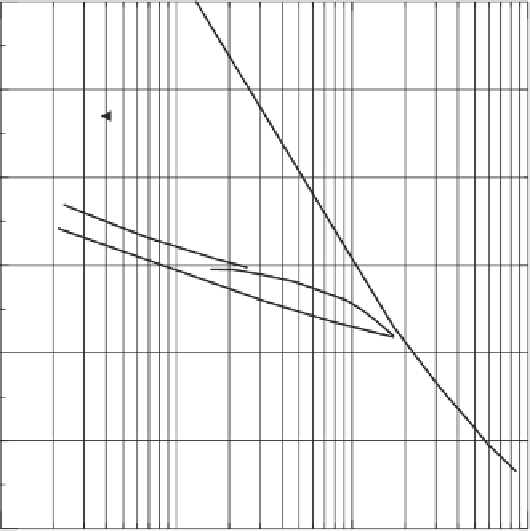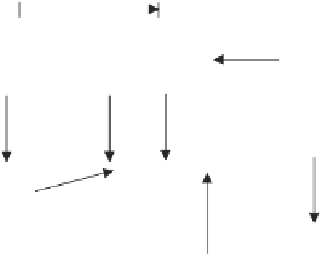Environmental Engineering Reference
In-Depth Information
1.4
Matric suction
equivalent
1.2
Virgin compression
branch,
C
c
Overburden
pressure
1
P
s
P
′
s
P
c
0.8
Rebound
0.6
Recompression
P
′
s
= corrected swelling pressure
0.4
P
s
= preconsolidation pressure
0.2
10
100
1000
10,000
log(
σ
-
u
a
), kPa
Figure 14.10
Relationship between corrected swelling pressure and preconsolidation pressure
of a soil.
The above equation is a modification of the common defi-
nition of the OCR associated with saturated soils. The OCR
is usually defined as the ratio of the preconsolidation pres-
sure
P
c
to the in situ vertical effective overburden pressure
σ
v
(i.e.,
σ
v
−
can be taken into account using appropriate volume change
indices for loading and unloading. It may also be possible to
assume that there is insufficient time for the soil to respond
to the individual loading and unloading stages. In this case,
the long-term volume change calculations can be computed
based on the final net loading or unloading conditions.
Let us assume that the final pore-water pressures in the soil
go to zero under a constant net normal stress. Figure 14.11
shows the actual stress path that would be followed by a soil
element at the depth from which the sample was retrieved.
Swelling would follow a path from the initial void ratio
e
0
to the final void ratio
e
f
along the rebound surface on
the matric suction plane. The entire rebound surface can be
assumed to be unique since the direction of deformation is
monotonic (Matyas and Radhakrishna, 1968; Fredlund and
Morgenstern, 1976). It is also possible to follow a stress path
from the in situ stress state to the corrected swelling pressure
and then proceed along the rebound curve on the net normal
stress plane to the final stress condition. The advantage of
the latter stress path (i.e., through the corrected swelling
pressure) is that the volume change indices determined on
the total stress plane can be used to calculate total heave.
u
w
, where
σ
v
=
total overburden pressure
and
u
w
pore-water pressure). The use of the corrected
swelling pressure
P
s
eliminates the need to measure the
in situ negative pore-water pressure when defining OCR.
Equation 14.13 provides an indication of the overconsoli-
dation of the soil with respect to the in situ stress state on
the net normal stress plane (i.e.,
P
s
). At the same time, it
is recognized that Eq. 14.13 is a deviation from the classic
definition of OCR.
=
14.4.4 Future Stress State and Ground Movements
The future stress state corresponding to several years after
construction must be estimated based upon local experience
and climatic conditions. There are several possible assump-
tions that can be made regarding possible future suctions
in the soil. There are general estimations that can be made
regarding the soil suction profile in the future and there are
also more rigorous analyses that can be performed by tak-
ing into consideration the climatic conditions measured at
nearby weather stations. Local watering practices could also
be taken into consideration.
Changes in total stress can occur as a result of excavation,
replacement with a relatively inert material (e.g., gravel),
and loadings from structures. The effects of these changes
14.4.5 Determination of In Situ Stress State Using
Oedometer Test Results
One-dimensional oedometer tests are commonly used for
the assessment of the in situ stress state and the swelling
properties of expansive, unsaturated soils. The oedometer

















Search WWH ::

Custom Search